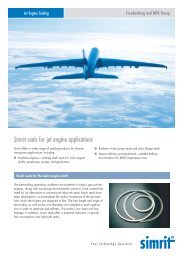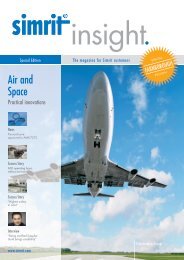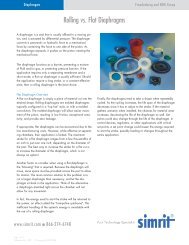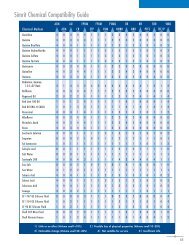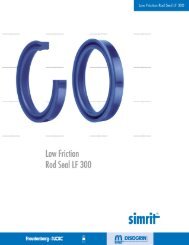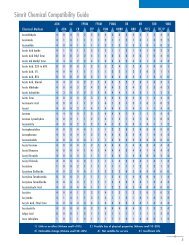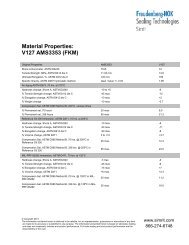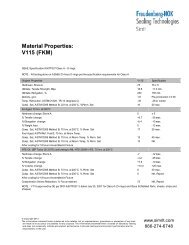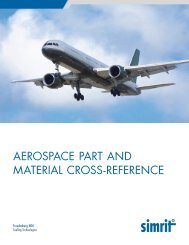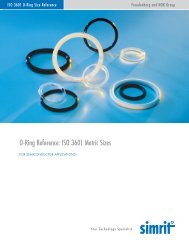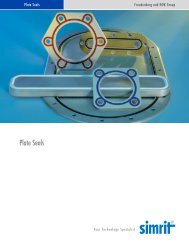Diaphragm Design Manual - Simrit
Diaphragm Design Manual - Simrit
Diaphragm Design Manual - Simrit
Create successful ePaper yourself
Turn your PDF publications into a flip-book with our unique Google optimized e-Paper software.
<strong>Design</strong> Guideline – Bead Compression25% +/- 5% compression on the bead is the recommendedstarting point. Higher compression may be required for highermodulus compounds or higher system pressures and visa versa forlower modulus and lower system pressures.Cylinder Diameter (CD) .25" / .99" 1.00" / 2.50" 2.51" / 4.00" 4.01" / 8.00" 8.01" & UpBead Groove Width .109" .141" .219" .281" .281"Bead Groove Height .076" .105" .160" .224" .224"Flange Corner Radius .031" .063" .094" .125" .125"Piston Corner Radius .031" .063" .094" .125" .125"Groove Lip Width .062" .125" .187" .250" .250"Groove Lip ClearanceFlange AreaThickness +.005"Flange AreaThickness +.005"Flange AreaThickness +.005"Flange AreaThickness +.005"Flange AreaThickness +.005"Table 16 – Dimensional Guidelines for Bead GroovesSolutions for Special Sealing ProblemsSometimes putting holes in what is supposed to be a non-permeable seal for piston hardwareattachment will conflict with application requirements for zero potential leak paths. In situationslike these, <strong>Simrit</strong> offers several sealing solution constructions that can give your diaphragmenhanced protection against these potential leak paths.One sealing solution option is to bond an insert to the diaphragm to act as a piston or as anattachment platform while still maintaining a non-permeable surface. Inserts such as these aretypically made of plastic or metal and can range from simple flat disks to complex machinedcomponents. In general, these types of bonded inserts are limited only by the temperatures andpressures of the molding process.Insert bonding can be accomplished in multiple ways depending on the specific need for theapplication. One option is to chemically attach the insert during the vulcanizing process using anadhesive. Another option would be to develop a cohesive bond between elastomer and insertthrough molecular attraction such as can be seen between sulphur cured Nitrile elastomers andbrass inserts. A third option is to mechanically attach an insert to the piston area of thediaphragm by allowing the elastomer to flow around and through it during the molding processand encapsulating it.Bonded inserts offer some additional benefits as they can aid in the assembly process byreducing or eliminating costly assembly steps as well as eliminate the need to purchase andinventory multiple components.A second sealing solution option <strong>Simrit</strong> offers are diaphragms clad with a barrier material whichcan reduce vapor permeation through the diaphragm, enhance the diaphragm’s temperaturehandling capabilities and offer an “FDA approved” surface on an otherwise “non-FDA” seal. Anexample of a barrier clad diaphragm is a PTFE foil or facing on the fluid side of a chemical pumpdiaphragm. This will enable the diaphragm to withstand harsh chemicals while still maintainingits flexibility and low hysteresis.© Copyright FNGP 200943



